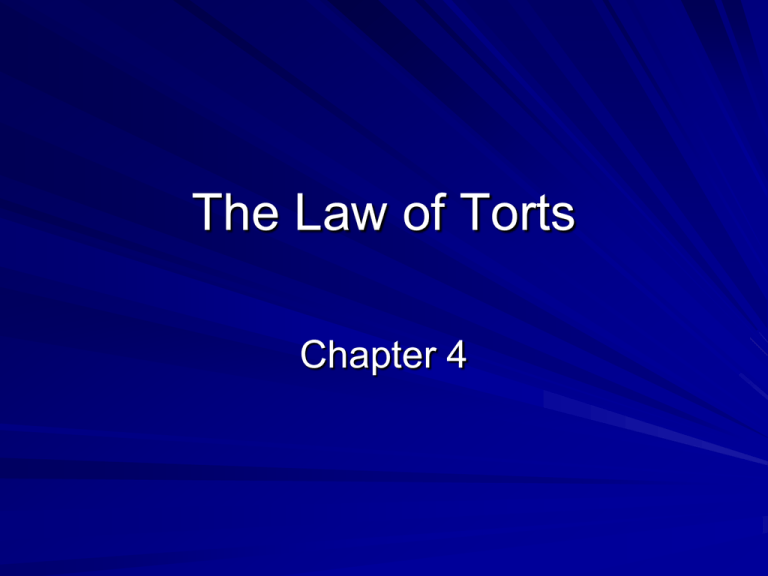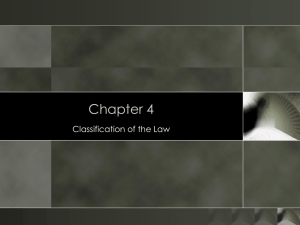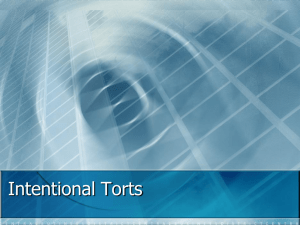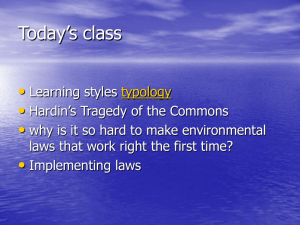File - Mrs. Dill's Site
advertisement

The Law of Torts Chapter 4 Civil Actions are Different Criminal Actions •Brought by the government •Government is prosecutor •Burden of proof – beyond a reasonable doubt •Defendant loses if found guilty •Usual penalty is a prison sentence Civil Actions – Brought by private citizens – Party starts action - plaintiff – Plaintiff has burden of proof – preponderance of the evidence – Defendant loses if found liable – Usual penalty is money damages Crimes v. Torts Law of torts grounded in the concept of rights – Rights and Duties Law imposes a duty on all of us to respect the rights of others One action can be both a crime and a tort. Tort law allows for compensation Torts are either intentional or unintentional Intentional Torts When a person knows the consequences of their actions – Deceit – Assault & Battery – Trespass – Nuisance – False Imprisonment – Defamation Libel (written) - Conversion - Infliction of Emotional Distress - Invasion of Privacy Slander (spoken) Negligence & Strict Liability Negligence is a type of tort - Unintentional To do something, or fail to do something, that the ordinary and prudent person would have done OR Injury caused by carelessness Strict Liability – injury caused by participation in an ultra-hazardous activity How to Prove Negligence The plaintiff needs to prove four elements by a preponderance of the evidence – Duty – Breach of Duty – Causation (two parts) – Damages 1. Duty Defined: “A legal obligation that is owed to another” Defendant failed to act as a reasonable person would have acted Example: If you drive a car, you have a duty to obey the rules of the road Duty -Continued Generally speaking, a person owes a “duty of care” to those around him or her How is this duty of care determined? – By an objective standard “would a reasonable or prudent person in the defendant’s position act as the defendant did? The Duty of Care: Example Would a reasonable person drive down the street with a paper grocery bag over her head? The reasonable person would not do this Thus, part of the duty of care when driving is to not obstruct your vision Who is the Reasonable Person? The reasonable person is a legal fiction The reasonable person considers: how likely a certain harm is to occur, how serious the harm would be if it did occur, and the burden involved in avoiding the harm Negligent Torts: Duty Can you think of examples of how the following people fulfill their duty of care?: 1. A lifeguard at a municipal pool. 2. A lumberjack felling a tree. 3. An owner of an aggressive dog. 4. A high school football coach. 2. Breach of Duty Defined: “Failure to use reasonable care” Once the duty is established, it is a simple matter to determine whether the defendant’s actions met this standard of care Problem #1: Duty and Breach Itchy comes to an uncontrolled intersection (i.e. no traffic lights or signs) on foot. He stops at the intersection, looks to the left and to the right and then crosses the street How would a “reasonable person” act? Did Itchy breach the standard of care? 3. Causation Proximate Cause – Legal connection between unreasonable conduct and harm The defendant’s conduct caused the plaintiff’s harm. The harm was foreseeable Cause in Fact: The “But For” Test How does the law determine what is a cause in fact? The “but for” test: If the defendant had not acted negligently (by breaching the standard of care), the plaintiff would not have been injured Proximate Cause: Foreseeability How do courts determine what is a proximate cause? Courts apply the foreseeability test “Was the injury to the plaintiff foreseeable at the time the defendant engaged in the unreasonable conduct?” Negligent Torts: Causation: Hypo This is Ken Griffey, Jr. Ken Griffey, Jr. likes to practice his swing in his living room. Unfortunately, this sometimes leads to disaster… Negligent Torts: Causation: Hypo 1 One day, while practicing his swing in his living room, Ken loses his grip on the bat. The bat flies into the sitting room and hits his wife’s friend in the head, causing minor injuries. Q1: Is there causation in fact? Q2: In there proximate causation? 4. Actual Harm A successful case must establish proof of actual harm. Did the plaintiff suffer injuries? Once you prove the actual, physical harm, the second aspect of damages comes into play: “Money claimed by, or ordered to be paid to, a person as compensation for loss or injury” – The law tries to restore the plaintiff to her pre-injury condition using money Types of Damages Actual Damages – Doctor Bills, Repair to Vehicles, etc. – Loss of Income Compensatory Damages – – – – Can be general or specific Pain & Suffering Loss of Companionship Loss of Reputation Punitive Damages Meant to punish the defendant Defenses to Negligence Suits Disprove any of the four elements As you know, it is rare that an accident is caused solely because of one person’s actions Contributory negligence defense: If the plaintiff’s own negligence contributed to the harm suffered, the plaintiff cannot collect anything from the defendant This defense is only used in a few states and is not the law in Wisconsin – Comparative negligence defense: Plaintiff’s recovery from the defendant is reduced by the percentage that the plaintiff’s own negligence contributed to the injury Defenses - Continued – Assumption of Risk – If you knowingly engage in an activity that is dangerous, you “assume the risk” of being hurt. – Consent Strict Liability Some activities so dangerous, neither principles or negligence nor intentional torts apply. People engaged in dangerous activities are held responsible for damages Only applies to ultra-hazardous situations. Can also be applied to product liability cases. The Law of Torts Chapter 4 Summary The information covered today is just the tip of the iceberg There is much more to learn: – – – – More defenses How to prove the monetary value of a claim to the jury Multiple causes of an injury Complex scenarios involving multiple plaintiffs and multiple defendants This lesson provides a good foundation so that you can evaluate your conduct in society and the conduct of others








